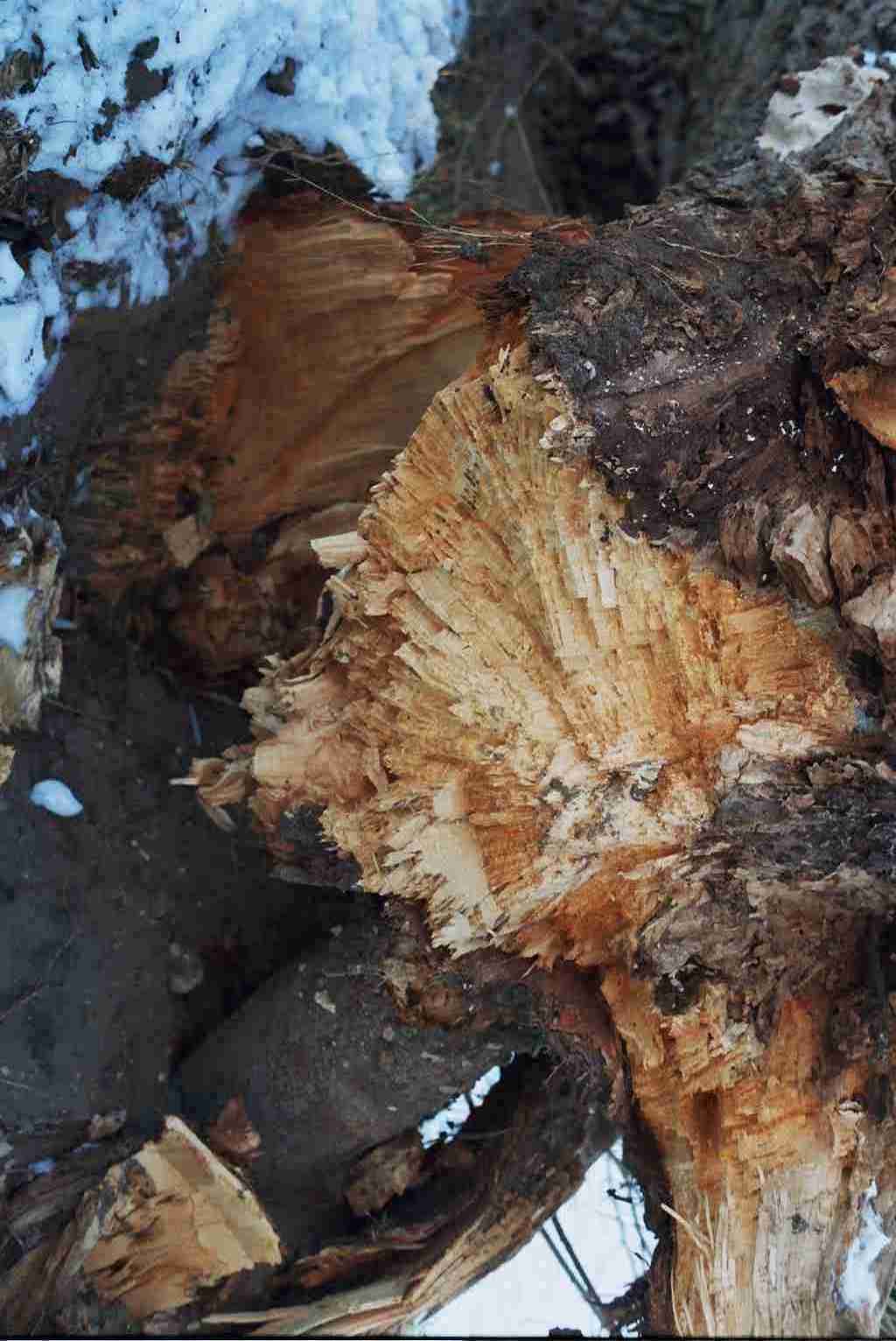
The photo of the fallen tree in Vilnius
The revelations in Vilnius and Eastbourne
John Bjarne Grover
In the morning 6 November 2001, I came out of my home in Vilnius and saw that a tree had broken at the root in the storm that night. The photo which I took of it (the photo is here turned 90 degrees clockwise) does in fact represent the whole poem which Nelly Sachs sent on 27 February 1960 to Paul Celan after he had written to her on 20 February 1960 a letter with the line "Und wir haben ein Kind, Nelly Sachs, ein Kind!" The tree fell in the night when I suppose that my 'congratulations' had reached prince Philippe and princess Mathilde in Belgium after the birth of their daughter Elizabeth. I took the following photo of the tree some days after it had fallen:

The photo of the fallen tree in Vilnius
It is Nelly Sachs' poem "Mund / saugend am Tod", from her 'Fahrt ins Staublose' published in 1961 - but, as tells her letter, completed at least as early as 27 February 1960. Could be it was written in response to Celan's letter to her? I have to quote the full poem for showing all the details in the mapping to this wonder of nature which tells of this poem:
Mund
saugend am Tod
und sternige Strahlen
mit den Geheimnissen des Blutes
fahren aus der Ader
daran Welt zur Tränke ging
und blühte
Sterben
bezieht seinen Standpunkt aus Schweigen
und das blicklose Auge
der aussichtslosen Staubverlassenheit
tritt über die Schwelle des Sehens
während das Drama der Zeit
eingesegnet wird
dicht hinter seinem eisigen Schweisstuch.
A closer study of the correlation shows that it represents the poem line by line in a curve which goes diagonally from top left to bottom right, from the fleshy parts with the open mouth up to the left down to the pharyngeal region to the right. Then it follows the picture up along the righthand side in the second part of the poem, untill it reaches the mask which is stepping over the threshold of seeing, crosses leftwards over the in-fallen part ('segnet' in Norwegian) onto the last line "dicht hinter seinem eisigen Schweisstuch" to the upper left.
See also the 'Poetic proof that sachs and Celan are my genetic parents' with Celan's version of the same photo.
Had it been an ordinary 'root sign' in this sign in the root of the tree, it would have gone to the right instead of to the left. Could be that also tells something of the 'imaginary unit' of complex numbers (the square root of minus one). There are reasons to believe that this could have been a part of a mathematical indexation of me - along with e.g. a 'pi' for Josef Mengele and an 'e' for Heinrich Himmler, or rather vice versa, for making the Fourier Transform from history to 'heaven'. If so, this could have been even the reason for the name of 'Paul Antschel' = 'polar angle' in polar coordinate notation of complex numbers. In which case this 'root sign' means precisely the exchange of letters between Celan and Sachs in February 1960.
The revelation is immensely rich in meaning and tells in fact an lot of other stories. See for example the dreadful school dentist in 90 degrees angle (tilt the head leftwards for seeing it) over the open 'Pinocchio' schoolboy mouth under the circular lamp. It is a part of the reason why I can believe that Sachs and Celan have something to do with me - which also could indicate that they are my genetic parents.
I must add also the photo of the spider who had built a webside between the toilet water basin and the bathtub in my bathroom in Vilnius some time earlier. The webside was about the size of the screen on the computer I was writing on, and the main theme seems to have been the 'Mengenle-hre' diagonal going across it - and which seems to add some comments on the interpretation of the root sign as being about the imaginary unit of complex numbers. Here is a photo of the webside, with spider in the upper lefthand part of it:

The webside which Spider made
It means that this is revelational poetry and poetic revelation. That again means that it is based on a metric of integrity and that information can be sent through eternity. Which means that time can go backwards and the poetry can alter the state of the world in the past and return to an altered material state of the world now. This is what the revelation in the root means: The world has been materially changed via information transmission through eternity. It is a proof that it is possible to send information through eternity.
Another strong example of how poetry can alter the material state of the world and hence constitute the basis for a new technology occurred when I packed for sending my 'Endmorgan Quartet' to the Poetry Society in London. I think I had prepared the package in the weekend and went on Monday morning 11 January 1999 to send the book, which I had completed a few weeks earlier, along with a short letter, from the post office. The next day, there were the news on the front page of The Times 12 January 1999 that a good slab of the white cliffs of 'Beachy Head' had fallen out in the sea, as it was discovered on Monday: In fact the vertical cliff wall had fallen out and crumbled into smaller rock parts which lay out in the sea to reach right out to a lighthouse outside the cliff. The crumbled rock nearly kissed the stairs up to the lighthouse and one could walk out to it on dry land - only 8 feet were missing. A real miracle! Time and frequency and things like that (see 'about the poetry'). It was no doubt that this interpreted the very turning point of the book which I had sent in the same morning. The parallel texts are in Luke 22.60-61: "60. Peter replied: 'Man, I don't know what you're talking about!' Just as he was speaking, the rooster crowed. 61. The Lord turned and looked straight at Peter". The title sonnet with the turning point of the first part of the full work is in parallel with this verse 61 - 'the Lord turned'. It is this which I had sent off to the Poetry Society. Immediately before this title sonnet, there is the text with the parallel "the rooster crowed", which goes as follows:
As mirror mixes time and frequency
I've clarified conception of eternity.
© John Bjarne Grover
It can be noticed that Spider was sitting in about the same position relative to the 'water-knee' in my bathroom as the face surrounded by the glory in the fallen tree. Another photo shows that the face in the revelation resembles a birth:

The fallen tree resembles a birth
This means that the revelation also is about my own 'Endmorgan Quartet', such as e.g. the last text in the first and 'temporal' part (see under 'poetry'). The third stanza in this poem ('It wasn't long...') is represented in amazing detail (not clearly visible with this resolution) in the scene in front of the main face, next to the 'amphora' on the wooden bend (with an ejaculating jacketed man, a woman and a scene of near sacrifice - see 'new revelation in Vilnius' where it also occurs in the fur of the cat - in total reminiscent of pope John Paul II's book of poetry 'A Rome triptych' from the autumn 2002). It is so precise that one cannot refrain from recognizing it from the poem. This is the poem which sums up the whole book in a dense representation of this theory of mine on 'the form of time'. The revelation is a proof that this is about sending information through eternity.
I think you passed. You were
thirtyone or thirtytwo.
in a mo-memorable cap,
the problem is: How can 'far' people get out at sea?
I went out to the time and sea
in Brighton Rock, but I couldn't find no secret.
This fragment, which is the one of the rock falling out in the sea at Beachy Head near Brighton when I sent the book, and which clearly is imitating a 'rooster's crow', was written on 12 May 1998 - the date of the death of Sachs and burial of Celan in 1970 (before the school dentist at 'Trosvik' drilled 31 holes in my teeth - an apparent 'revenge' after their death). The crow of the rooster ends with a sort of indeterminate 'giving up': It should have been "I couldn't solve the problem" but that is too specific and also wrong, and neither is "I couldn't find the problem" much to the point, and so forth. The title sonnet following immediately after was written on Fatima day 13 May. The landslide was reported in The Times on 12 January 1999 with a large photo covering nearly half the front page of the fall cliff and the lighthouse, and in the lower half 'Blair makes NHS key to New Labour relaunch", with a drawing of a sign at the crumbling Beachy Head saying "Beachy Head (twinned with New Labour)". Next to it the newspiece 'Yemen prepares to charge Britons'. Which seems to suggest that Blair had grabbed the chance to make a 'landslide' strategy out of the event - if he had not simply made it himself. It is probably not likely that such a cliff could have been dynamited out in the sea - just out to the lighthouse.
The landslide at Beachy Head and the revelation in the fallen tree in Vilnius are clearly interrelated. If the fallen tree in Vilnius is about Nelly Sachs, the landslide at Beachy Head is about 'Paul Celan' = 'pole see/sea land'.
On the web 8 March 2005
Edited version on 11 June 2006
Last updated 5 December 2007